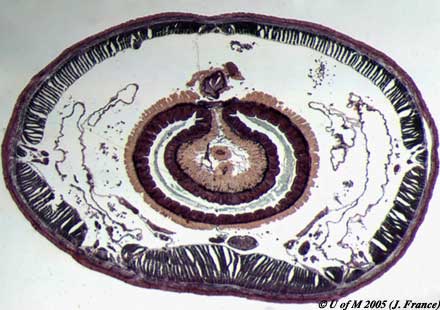
 |
Phylum Annelida
Canadian Campbell 2nd ed Pages 742 - 745)
The annelids are segmented worms and consist of three classes:
 Examine
cross sections of the earthworm Lumbricus taken through the intestinal
region:
Examine
cross sections of the earthworm Lumbricus taken through the intestinal
region:
In the sections note the following features. The body wall is composed of four layers. The outermost layer is the thin, noncellular cuticle secreted by the epidermis, which consists of a layer of columnar epithelial cells, among which are many glandular cells. Beneath the epidermis is a layer of circular muscle fibers. The next and thickest layer of the body wall is made up of longitudinal muscle fibers arranged in a feather-like pattern. The innermost layer of the body wall consists of a thin layer of flattened cells composing the peritoneum. The coelom (image) is the space between the body wall and the digestive cavity. In the coelomic cavity, locate the dorsal and ventral blood vessels and the solid ventral nerve cord.
The thin-walled intestine bulges laterally in each segment; its dorsal wall has an infolded typhlosole. The wall of the intestine is composed of three layers. The outermost layer is made up of slender columnar cells containing numerous granules and chloragogue cells (mesodermal origin). You should make a sketch of the above structures.
Consider the following questions:
The earthworm also illustrates segmentation.
Examine sketch of a worm and note the segmented body plan
![]()
